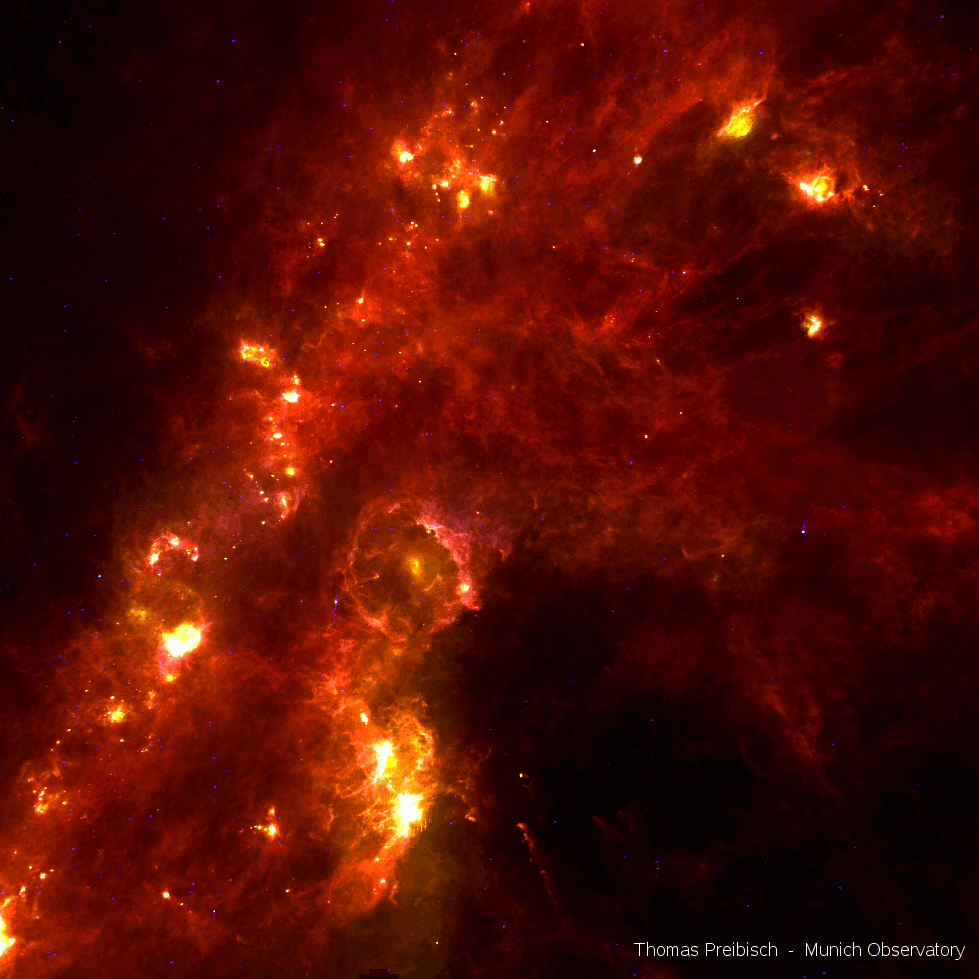
Image Credit: Thomas Preibisch
In MWM, we use the term “YSO” to refer to the phases of stellar evolution between protostars and the main sequence. Because O and B stars evolve so quickly to the main sequence, they are not seen in these phases and are mainly observed under the OB program. Therefore this program focuses on lower mass stars. The highest priority target classes are those based on all-sky photometry.
Target selection for YSOs is not straightforward, because they show a wide range of physical properties as they move from protostars to pre-main-sequence stars, complicated by nebular emission, line-of-sight extinction, and mass dependence. Kounkel et al (2023, submitted) provides the comprehensive discussion of YSO targets through target generation v0.5.3. We provide a short summary here.
APOGEE and BOSS spectra
Both infrared APOGEE and optical BOSS spectra contain useful information for YSOs. However, some of the cartons discussed below do not have optical magnitudes bright enough to obtain reasonable signal-to-noise in a single exposure. Therefore only a subset of methods have both _apogee and _boss versions for cartons. The selection criteria are the same for both instruments, with the exception of the limiting apparent magnitude and band.
Cartons
Disk
These YSOs are identified by large infrared excesses due to protoplanetary disks. WISE colors are particularly helpful in this regard. The major contaminant are distant field stars that are highly extincted so a parallax cut is included.
Embedded
These stars are too faint in the optical for reliable parallaxes because they are still embedded in their natal envelopes, have edge-on disks, or have more extinction along the line of sight. Without the parallax constraint, more stringent color cuts on both the AllWISE and 2MASS photometry are needed to avoid extensive contamination by reddened field stars.
Nebula
In regions of high nebulosity, the WISE W3 and W4 bands can become saturated with nebular emission. Therefore, where W3 and W4 information is not available, we use shorter wavelength information. We also exclude certain regions of the sky which produce spurious sources following the scanning law of the WISE telescope.
Central Molecular Zone
The central molecular zone (CMZ) is the most extreme star-forming environment in the Milky Way and is hidden behind many magnitudes of optical extinction. This area covers a relatively small fraction of the sky compared to the all-sky nature of the previous selections. There is deeper targeted data from the GLIMPSE and MIPSGAL programs that cover the inner Galaxy. These data offer a substantial improvement in sensitivity and resolution compared to WISE and are used in selecting targets for the this carton.
Variable
YSOs are on average more variable than main-sequence stars of the same color, which provides a way of identifying them when their disks have evaporated enough and no longer provide a large infrared excess. This works particularly well for cooler stars, where the higher activity of young stars leads to more spots and hence larger photometric variability. The multi-epoch photometry from Gaia provides the all-sky data needed for this method.
Following Belokurov et al. (2017), we define the photometry variability in a given Gaia filter x as
![]()
where phot_x_n_nobs is the number of observations that contributed to the photometry in a given band and phot_x_mean_flux_over_error is the mean flux in a given band divided by its error. Both values are from Gaia DR2.
Pre-Main Sequence
This method relies on finding young low-mass stars by their location above the main sequence on the HR diagram as they continue their slow contraction. There have been several dedicated studies that focused on identifying such stars through Gaia DR2 photometry and astrometry, and we draw targets from two such studies, Zari et al (2018) and McBride (2021), for these cartons.
Cluster
A stars collapse quickly to the main sequence but once there, their lives are relatively long. Unlike O and early B stars, observing an A star in the field is not a guarantee that it will to be < 100 Myr old. With neither short lives on the main sequence nor obvious pre-main-sequence phases, we require additional information to find truly young A stars. We rely on the fact that stars are born in associations to find these intermediate mass stars. These cartons select all stars from moving groups with an age < 107.5 yr from the analysis of Kounkel et al. (2020) using the Gaia DR2 data.
Young Stellar Object Cartons in Target Generation 0.5.3
The YSO cartons for target generation v0.5.3 use magnitudes from the 2MASS Point Source Catalog, AllWISE, and Gaia DR2 and parallaxes (in mas) from Gaia DR2. In addition, the CMZ carton uses Spitzer magnitudes from Gutermuth and Heyer (2015). All criteria are required unless there is an “OR” statement.
- mwm_yso_disk_apogee
- H < 13
- W1-W2 > 0.25
- W2-W3 > 0.50
- W3-W4> 1.50
- parallax > 0.3 mas
- mwm_yso_disk_boss
- Rp < 15.5
- W1-W2 > 0.25
- W2-W3 > 0.50
- W3-W4> 1.50
- parallax > 0.3 mas
- mwm_yso_embedded_apogee
- H < 13
- G > 18.5 or undetected
- J-H > 1
- H-K > 0.5
- W1-W2 > 0.5
- W2-W3 > 1
- W3-W4 > 1.5
- W3-W4 > 0.8*(W1-W2)+1.1
- mwm_yso_nebula_apogee
- H < 13
- W4 not reported and W2-W3 > 4 OR
- W3, W4 not reported and J-H > 1.1
- b < 5 deg
- b > -5 deg OR l > 180 deg
- mwm_yso_cmz_apogee
- H< 13
- [8.0]-[24] > 2.5 in the catalog of Gutermuth and Heyer (2015) available on the CDS
- parallax < 0.2 or not measured
- mwm_yso_variable_apogee
- H < 13
- G < 18.5
- parallax > 0.3
- VG > 0.02
- VBP > 0.02
- VRP > 0.02
- VG0.75 < VBP < VG
- 0.75 VG < VRP < VG0.95
- GBP – GRP > 1.3
- MBP > 5 log10VBP + 11 where MBP = GBP-5*(log10(1000/parallax)-1)
- 2.5 * (GBP-GRP) -1 < MG < 2.5 * (GBP-GRP) + 2.5 where MG = G-5*(log10(1000/parallax)-1)
- parallax > 0.3
- mwm_yso_variable_boss
- same as above, including both the H-band and G-band magnitude limits
- mwm_yso_pms_apogee
- mwm_yso_pms_boss
- mwm_yso_cluster_apogee
- mwm_yso_cluster_boss
Cadences
All of the _apogee cartons have the bright_3x1 cadence.
All of the _boss cartons have a bright cadence determine by their GRP magnitude.
- GRP< 14.76 — bright_3x1
- 14.76 ≤ GRP < 15.075 — bright_4x1
- 15.075 ≤ GRP < 15.29 — bright_5x1
- 15.29 ≤ GRP < 15.5 — bright_6x1
